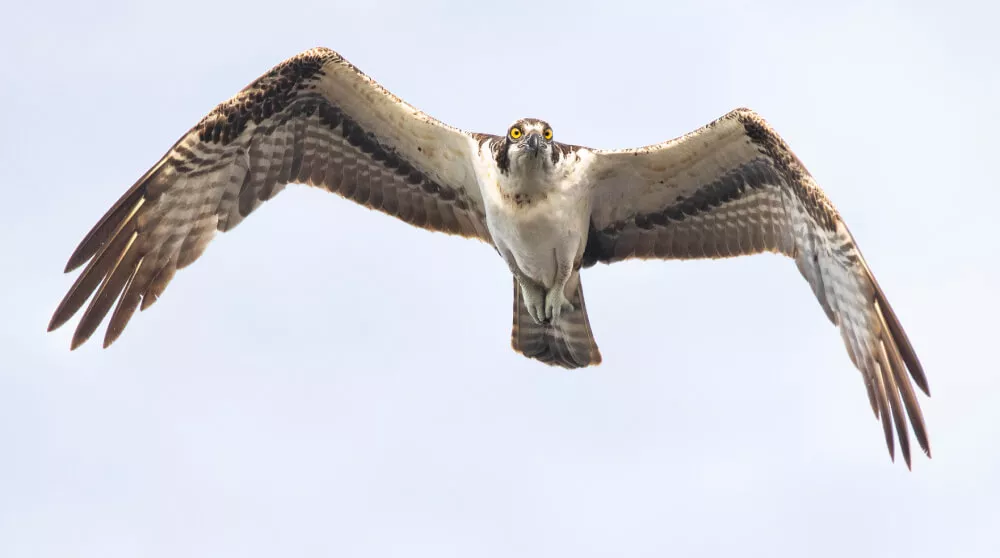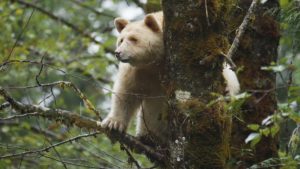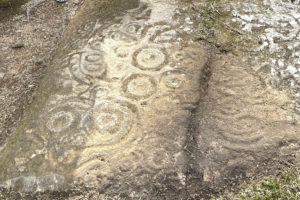Birds of Great Bear Rainforest
The Great Bear Rainforest is known for its wide biodiversity, especially its variety of rare birds, such as bald eagles and white pelicans. So grab your binoculars and camera and experience all that the Great Bear Rainforest has to offer! When it comes to wildlife, the Great Bear Rainforest is a bird watchers paradise. The massive area of old-growth forest combined with a long rugged coastline makes a home for an incredible array of avian species, most of which are quite rare.
Here’s a guide to just some of the amazing birds you’ll meet upon arrival at the Rainforest, including some interesting facts about the birds and how best to view them in their natural habitat. Some of the birds you need to keep a weathered eye out for include Bald Eagles, Ospreys, Peregrine Falcons and of course the White Pelican.
Bald Eagles Of Great Bear Rainforest

Bald eagles are one of the most iconic birds in North America. These majestic creatures are known for their impressive size, 2 meter long wingspan and striking white head and yellow beak. They also have super great eyesight, allowing them to spot their prey from very far away. They can actually see four to seven times farther than humans, so he’ll be spotting you before you spot him!
Bald eagles primarily eat fish and are known for their thrilling swoop and pluck technique while catching their meals. They tend to habitat near large bodies of water, high up in the tree line isolated from humans. So if you’re in for a chance at catching a glimpse of this impressive bird, you better be in stealth mode.
A fun fact about bald eagles is when they lose a feather on one wing, it will then lose a feather on the other wing to keep itself balanced, so keep an eye out for the eagle’s fallen wings on your hike!
Ospreys, The ‘Fish Hawk’ Of The Great Bear Rainforest

Ospreys, like the Bald Eagle, have an impressive wingspan of 2 meters, however they differ in colour and can be harder to spot due to their neutral colouring. Their Dark brown upperpart and white underbelly make them blend easier into their surroundings. A distinctive feature to look out for would be the brown stripe running through the Osprey’s eye, almost like a mask.
The Osprey’s nickname ‘fish hawk’ comes from, you guessed it, their main food source fish.
Unlike other raptors, the Osprey has four equal toes. The outer toe is reversible, therefore the bird can catch its prey with two toes pointing forward and two pointing backward. The bird’s hold on its slippery prey, which mostly consists of fish that it catches alive, is provided by long, sharp, curved claws on each toe and short, inflexible spikes, known as spicules, on the sole of each foot. This makes the Osprey an incredible hunter who never fails to make a catch, giving the bird the nickname ‘fishing eagle’ or ‘fish hawk’. You do not want to get in the way of this guy when he is in hunting mode!
They are found close to large bodies of water, making their nests near to the river and lakes in Great Bear Rainforest. Keep an eye out for their enormous nests at the top of large trees near the water’s edge. The tree may be living or dead, but it should ideally be able to support the weight of the nest, which is made up of a massive collection of dry branches that have been weaved together with various materials like stakes, rope, strips of old fabric, plastic, and even caribou antlers.
You might just have a reference photo of the Osprey hidden in your wallet without your knowledge! The Osprey was featured on the Canadian $10 bill for many years, being released in 1989 before being replaced in 2001.
The Wandering Peregrine Falcon

Peregrine Falcons are the most widespread birds of prey in the world, giving it its nickname the wandering falcon luckily for you bird lovers, they also reside in Great Bear Rainforest. At a glance you’ll recognise the Peregrine with its dark head and “mustache”, giving the bird an eerie, hooded appearance. Their striking yet spectral look, combined with their incredible speed, makes them a nightmare predator. In pursuit of their prey, other birds, they can fly 60 mph straight forward. This is a leisurely stroll for our impressive Peregrine Falcon because when they enter a hunting dive called a stoop, they can reach up to 200 to 240 miles per hour! This makes them one of the fastest animals on the planet so keep your binoculars at the ready or you just might miss him swoop by!
You are most likely to find peregrine falcon nests on the edge of cliffs or other tall structures. Nest may not be the best term for Peregrine Falcons, as they usually create a type of large ‘scrape’ made up of sticks and trees. You are most likely to find a peregrine falcon nest in the Great Bear Rainforest on a tall tree. Just like the Osprey, Peregrine Falcons mate for life, so they typically return to the same nesting place year after year. This makes the Great Bear Rainforest a prominent location for spotting a Peregrine Falcon in its natural habitat.
Peregrine Falcons are favored by falconers and have been trained for falconry hunting for more than a thousand years. In fact, captive breeding by falconers was instrumental in the conservation and restoration of the species after its population was devastated by the chemical DDT. These efforts succeeded in boosting Peregrine Falcon numbers as there are now more Peregrines globally than there were before the 20th century decline.
White Pelicans

The White Pelican is one of the most interesting species residing in the Great Bear Rainforest. You are most likely to spot The White Pelican during the summer months as they usually migrate south coming into winter to be nearer to warmer coastlines. It would be pretty hard to miss the White Pelican due to its enormous size. They weigh between 5.0 and 9.1kg and their wingspan alone gives birds like the Bald Eagle a run for its money when fully spread the wings spread over 2.7m tip to tip! This makes the White Pelican’s wingspan the second largest in North America, behind the California Condor.
You are bound to spot this magnificent creature roaming the water’s edge of the Great Bear Rainforest, scooping up fish with its impressively large yellow bill. White pelicans eat a variety of different fish, but their favorite food is the Whitefish. White Pelicans are very social creatures and often hunt in groups. When they spot a school of fish, they will work together to surround the fish and then scoop them up in their large bills. White Pelicans will also eat crustaceans, insects, and small mammals.
They also stay along the water’s edge to breed and raise their young, with the White Pelican typically laying 3-4 eggs per clutch, which hatch after about a month. Therefore, along the rivers and lakes of the Great Bear Rainforest is the most likely place to spot these mesmerizing creatures. Also, if you’re lucky enough to see them flying in V-formation it’s promised to be an unforgettable experience, they almost look prehistoric!
Without a doubt, the Great Bear Rainforest is a bird lover’s paradise. From the iconic Bald Eagle to the ominous wandering Peregrine Falcon, this location does not disappoint with its diverse ecosystem just waiting to be explored and enjoyed by you. Go and observe the Peregrine Falcon’s striking hunting stoop and witness the White Pelicans gracefully glide through the skies, it’s promised to be an unforgettable experience. These birds are only a few of the many that await you upon your arrival at the Great Bear Rainforest, a few that make the Rainforest a very special, magical place to visit.
Where to stay in Great Bear Rainforest
Embarking on a journey to the enchanting Great Bear Rainforest? Wondering where to stay in the Great Bear Rainforest? Look no further! Our dedicated page boasts a myriad of accommodation options, tailored to every traveler’s preference. Whether you’re seeking a cozy cabin, a luxurious lodge, or an immersive eco-retreat, we’ve got it all covered.
The best part? Each place is nestled amidst the pristine wilderness, offering you an unparalleled experience, surrounded by the majestic beauty of nature. Dive deep into the heart of the forest, wake up to the soothing sounds of nature, and let the awe-inspiring landscapes take your breath away. Begin browsing and let the adventure begin!





